Blepharoplasty improves the appearance of baggy, droopy, dark and tired eyes, and can take years off of your appearance. Powerful and lasting results from this procedure can restore a more rested, youthful and more alert you.
Blepharoplasty, commonly referred to as eyelid surgery, will target changes related to aging, stress and genetics that may make you appear worried, angry or fatigued. By removing excess fat and skin from the upper eyelid, lower eyelid, or both, a blepharoplasty enhances the contour of the eyes to restore a radiant and youthful appearance, letting your eyes redefine you.
Eyelid blepharoplasty, also known as an eyelid lift or eyelid surgery, is a procedure that is designed to improve the appearance of the eyelids. This procedure can be performed on the upper eyelids, lower eyelids, or both. During the procedure, excess skin and fat are removed from the eyelids to create a more youthful and refreshed appearance. Eyelid blepharoplasty can be performed for both cosmetic and functional reasons. In some cases, excess skin on the upper eyelids can obstruct vision, and eyelid surgery can help to improve vision by removing the excess skin. The procedure is usually performed under local anaesthesia, and the recovery time is typically short. The results of eyelid blepharoplasty are usually long-lasting and can help to improve the patient’s self-confidence and overall quality of life.
Blepharoplasty, more commonly referred to as eyelid surgery, involves the removal and restructure of excess skin, fat and stretched tissue around the eyes. By creating natural creases, redistributing fat pockets and removing excessive skin and tissue, the SixSurgery team is able to deliver an appearance to patients that would otherwise be unattainable as age and genetics works against us. These powerful techniques can be performed to address changes of the upper eyelid, lower eyelid, or both. Eyelid surgery is accomplished with minimal scarring and natural results.
Candidates interested in a blepharoplasty are commonly 30 years of age or older and looking to restore their lost elasticity and youthful appearance. Double eyelid surgery may be considered for any patient interested in creating or increasing the prominence of an eyelid crease. Blepharoplasty is best performed on patient without underlying eye conditions such as diabetes, glaucoma, and hypothyroidism.
The most suitable form of the following blepharoplasty procedures will depend on where stretched skin and excess fatty deposits are located around the eyes. As experts in facial anatomy, the SixSurgery team will determine the best approach during your consultation
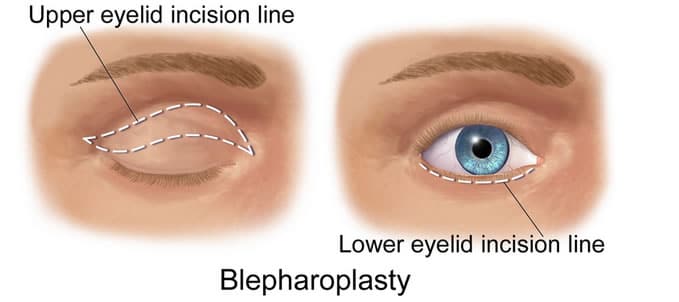
Upper Blepharoplasty involves the removal of excess tissue and stretched skin that causes wrinkles or hooding on the upper eyelid. Removal of excess tissue reduces wrinkles and hooding above the lash line, and creates the appearance of open and attentive eyes.
Where there is excessive drooping of the eyelid, a muscle repair can be performed through the incision at the same time. Brow lifts are commonly requested by patients for full facial rejuvenation. Blepharoplasty scars heal beautifully and are hidden in the natural creases of the eyelid.
Lower Blepharoplasty involves the redistribution and removal of excess fat under the eyes that causes the appearance of bags and under-eye puffiness. Removal of excess fat and tissue under the eyes creates the appearance of rested and rejuvenated eyes.
In this procedure, an incision is made just below the lower lash line. Excess skin in the lower eyelid is removed using this incision, and fat will be redistributed to remove the appearance of bags and under-eye puffiness. At times, the SixSurgery team may also make an incision that is hidden inside the lower eyelid, known as a transconjunctival incision, to correct lower eyelid conditions, or to redistribute or remove any excessive fat.
If the transconjunctival approach is used, there will be no visible incision.
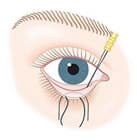
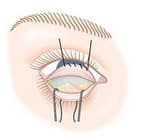
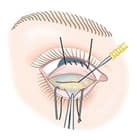
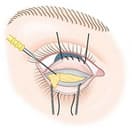
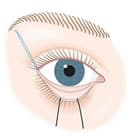
This technique uses sutures to create a crease in the eyelid. The SixSurgery team will create a depression in the skin by attaching the skin to the deeper structures located within the eyelid.
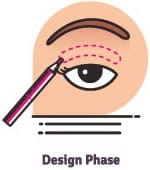
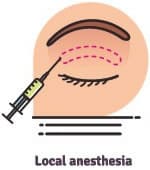
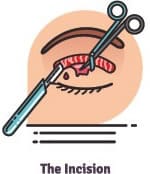
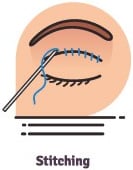
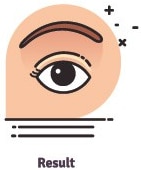
This technique involves the skin being cut and creating a new skin crease by attaching the cut edges of the skin to the deeper structures of the eyelid.
The most common method of creating the crease is known as the double sutures and twisting method, or DST. The DST procedure involves creating a fold by pinching together the underside of the eyelid skin and stitching it in place. The doctor may also trim the web of skin that overlaps the corner of the eye. This skin is more prominent in patients of Asian descent.

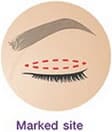
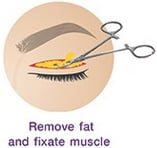
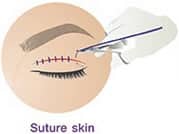
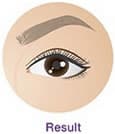
Costs will be adjusted according to anesthetic used and potential customization to the procedure. Costs are subject to HST and include both eyes. Here is more information on Blepharoplasty Eyelid Surgery Cost
In some patients a forehead or eyebrow lift is recommended at the same time as eyelid surgery. A brow lift aims to reposition low or sagging eyebrows, and helps to minimize the creases that occur across the forehead and high on the bridge of the nose. This helps to reposition eyelid tissues appropriately for optimal blepharoplasty results, and restores a youthful and more rested appearance to the upper third of the face.
There are several types of eyebrow lifts procedures available, including:
This procedure uses one continuous incision, that begins at the level of your ears and goes up and around the hairline.
This is a minimally invasive procedure that uses small incisions in the scalp, resulting in minimal scarring.
A procedure that adjusts the brow position using an eyelid incision. This is a great procedure when done at the same time as the upper eyelid surgery.
A procedure which involves making a small incision directly above the eyebrows and is ideal for older patients with wrinkles on their foreheads.
Most patients recover within two weeks, and it may take several weeks to see the final results of an eyebrow lift. The SixSurgery team will assess your unique facial anatomy and help determine if you would benefit from this surgery in combination with your eyelid surgery.
The surgery is not painful and patients will be under local or general anesthesthetic during the procedure. Cold compresses, eye drops and ointment will be used for your comfort as you recover, and mild bruising will be present for 1 – 2 weeks post-op. Most patients can manage their pain following the procedure using over the counter medications.
There will be minor bruising and swelling after the surgery which will last for approximately 1 – 2 weeks. Keeping the head elevated and getting plenty of rest will help expedite the healing process. Patients can return to work within 4 – 5 days after the surgery and are recommended to wait 1 – 2 weeks (before doing what?).
Results are immediate and will continue to improve over the next two weeks post-op.
The benefits of eyelid surgery will last indefinitely. Revision surgery for this procedure is very rare. Understand, however, that following your surgery your body will continue to age and so will the results of the surgery.
In this procedure, scars heal beautifully and are hidden in the natural creases of the eyelid. In most upper blepharoplasty cases, scars are not visible when the eyes are open. Depending on what blepharoplasty the SixSurgery team recommends for you, the incision may be hidden inside the lower eyelid. This procedure, known as a transconjunctival incision, is used to correct lower eyelid conditions or to redistribute or remove any excessive fat.
The procedure takes approximately two hours if both the upper and lower eyelids are completed at the same time. If other procedures are added, such as an eyebrow lift, it will increase the surgery length. Timelines can be discussed during your consultation.
Asian blepharoplasty is a type of eyelid surgery that creates a crease in the upper eyelid when the crease is absent. About 50% of Asians are born without an upper eyelid crease, and these men and women opt for this surgery to provide additional definition to the eye.
The most commonly recommended procedure to be combined with eyelid surgery is an eyebrow lift. An eyebrow lift repositions low or sagging eyebrows, which will complement and enhance the eyelid surgery. A brow lift also helps minimize creases that occur across the forehead, or those that appear high on the bridge of the nose. You may also ask the SixSurgery team about a face lift, “mini face lift” and other facial rejuvenation procedures that may be safely combined with an eyelid surgery.
It is important to rest and avoid strenuous activities for the first several weeks following the surgery. Most patients are able to resume exercise three weeks after their procedure.
Patients can resume wearing making after a few weeks post-surgery.